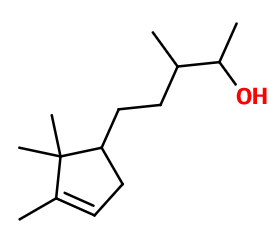Sandalore®
Synthétique
Woody > Sandalwood > Milky > Grapefruit > Leather

Crédits photo: ScenTree SAS
Other names :
3-methyl-5-(2,2,3-trimethyl-1-cyclopent-3-enyl)pentan-2-ol ; Dersantol ; Landasweet ; Pentamethyl cyclopent-3-ene butanol ; Alpha,beta,2,2,3-pentamethyl cyclopent-3-ene-1-butanol ; Sandal pentanol ; Sandal touch ; Sandalorex ; Sandasweet
Volatility :
Base
Uses in perfumery :
Sandalore® is used in sandalwood reproductions, woody notes for bringing volume and trail. Used for a milky and creamy effect in sandalwood notes. To be combined with other sandalwood notes such as Sandela®, Bacdanol® or Polysantol®. Not to be put in candle base. Tends to flatten accords.
Natural availability :
Sandalore® is not available in its natural state.
Year of discovery :
1976
Other comments :
Sandalore® is less milky than Sandela® and less potent than Bacdanol®.
Price Range :
€€
Stability :
Unstable in acid cleaners and in very alkaline products.

Crédits photo: ScenTree SAS
- Molecular formula :
- C14H26O
- Molecular Weight :
- 210,36 g/mol
- Density :
- 0,898
- Flash Point :
- 95°C
- Fusion Point :
- <-50°C
- Appearance :
- Colorless viscous liquid
- Log P :
- 4,7
- Boiling Point :
- 275°C
- Detection Threshold :
- Donnée indisponible.
Synthesis route :
Sandalore® is synthesized by a condensation of Campholenal with Methyl Ethyl Ketone. Then, two compounds are obtained and catalytically hydrogenated to ensure a selectivity of this hydrogenation (the alcene function of the ring must not be hydrogenated). A mixture of two hydrogenated molecules is obtained. These two isomers can be separated by a fractional distillation, or used together, as their smell is similar. The term Sandalore® refers to only one of these two molecules.
Synthesis precursor :
Sandalore® is not a precursor to the synthesis of another compound of olfactory interest.
Isomerism :
The isomer of Sandalore® formed during the synthesis has a ramified alcohol function, while Sandalore® has it on its main carbon chain.
Sandalore® has two asymmetric carbons. It is therefore a mixture of isomers that is used even when Sandalore® is isolated.
Adoxal® is a constitutional isomer of Sandalore®. Its smell is however radically different, as it is marine and aldehydic.
- EINECS number :
- 265-453-0
- FEMA number :
- Donnée indisponible.
- JECFA number :
- Donnée indisponible.
- FLAVIS number :
- Donnée indisponible.
- Allergens :
- This ingredient does not contain any allergen.
- IFRA :
- This ingredient is restricted by IFRA
- Restriction type :
- RESTRICTION
- Cause of restriction :
- DERMAL SENSITIZATION
- Amendment :
- 49
- Quantitative limit on the use :
-
Cat.1 Cat.2 Cat.3 Cat.4 Cat.5A Cat.5B Cat.5C Cat.5D Cat.6 0,21 % 0,062 % 1,2 % 1,2 % 0,29 % 0,29 % 0,29 % 0,29 % 0,68 % Cat.7A Cat.7B Cat.8 Cat.9 Cat.10A Cat.10B Cat.11A Cat.11B Cat.12 2,4 % 2,4 % 0,12 % 2,3 % 8,1 % 8,1 % 4,5 % 4,5 % No Restriction
This ingredient is not restricted for the 48th amendment
To learn more about IFRA's standards : https://ifrafragrance.org/safe-use/library
ScenTree is solely responsible for the information provided here.


